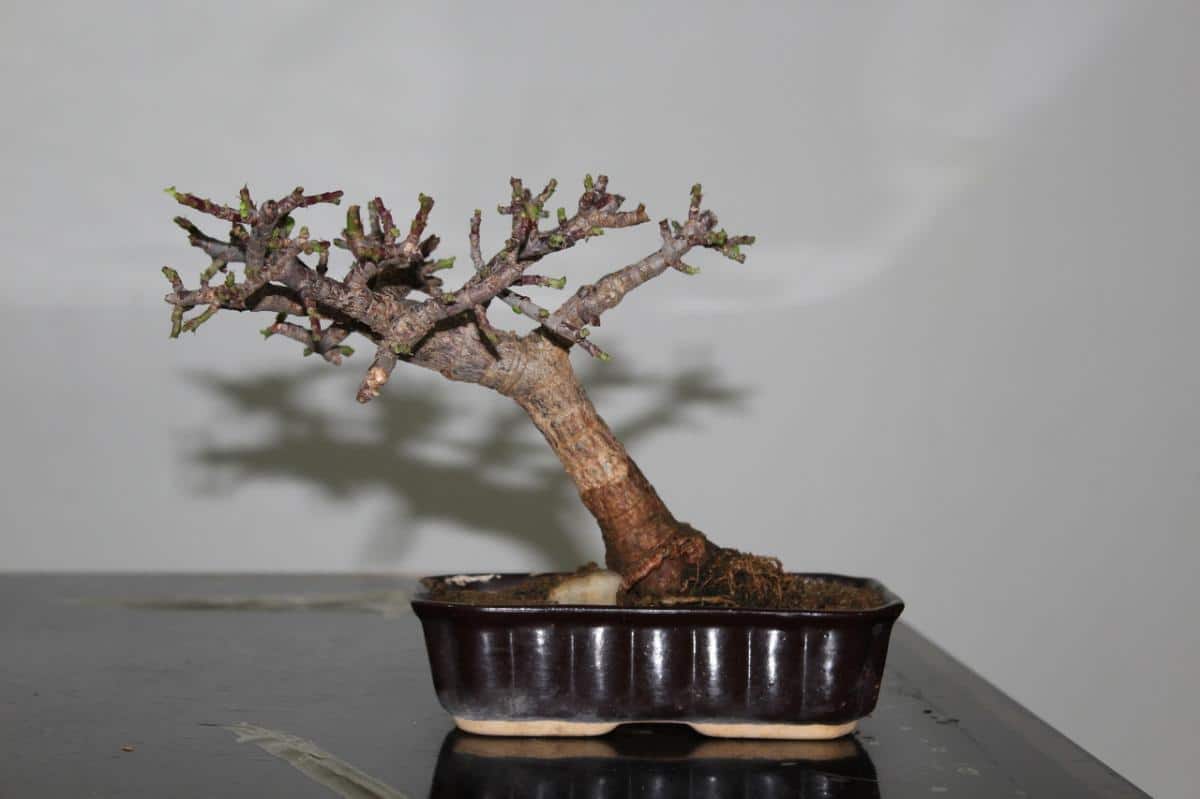

Is it possible to recover a dry bonsai? When we find it like this, we have to act fast, since it is possible that it has some really serious problem, such as a fungal disease as a result of excessive watering.
For this reason, it is important to know why it is dry, and also what we can do to recover it. In this way, there may be chances to save it.
Lack of water
Lack of water is a problem for bonsai: as it has very little land, it dries up very quickly. If it is also summer and we are in the middle of a heat wave, the situation gets much worse. And it gets even worse if it has akadama or another type of sandy substrate as a substrate, since it loses moisture at a faster rate than peat or mulch, for example. Therefore, we cannot neglect irrigation.
But How to know if our bonsai is thirsty? For this:
- The tips of the leaves will quickly turn brown, until they eventually fall off.
- If it has flowers, they will abort and fall off.
- The soil is dry, so much so that when we take the bonsai tray we notice it is very light.
- Pests may appear, such as mealybugs or aphids, which take advantage of the tree’s weakness.
Now, although the lack of irrigation is a serious problem, it is the one with the simplest solution: simply put the bonsai tray in a container of water for a few minutes. And then water more often. In general, you should hydrate an average of 3-4 times a week in the summer, and 2-3 times a week the rest of the year, but this is only a guide and should be used as such. If you live in an area where it rains frequently, you will have to water less than in another where it hardly ever rains.
Excess of water


Do you suspect that you watered your bonsai too much? Excess watering is another reason why these plants lose their leaves quite quickly. If before we have said that, as it has little land, it can dry quicklyif you water too much the roots will drownliterally. In extreme cases, there may be such an excess of water that the tree runs out of oxygen.
Therefore, we will see these symptoms:
- First, we will see that the tips of the leaves dry up, and then there comes a time when they fall off.
- The soil will look damp, and verdigris may appear if it is peat or other similar substrate.
- It may have fungi in the soil and/or in any of its parts (roots, trunk).
- When taking the bonsai tray, we will notice that it weighs.
What to do? I recommend treating it with polyvalent fungicide what can you buy here!, since fungi are microorganisms that not only love excess moisture, but also cause serious damage to plants.


Related article:
Excess irrigation in bonsai: how to avoid it and solve it
Likewise, you have to remove the tree from the tray, and wrap its roots -without removing the substrate- with absorbent kitchen paper. If we see that it gets wet very quickly, we will remove it and put another one on it. Then, we will leave it like that overnight, and then plant it back in its tray the next morning.
And of course, from then on we have to water less oftenletting the soil dry out a bit before rehydrating it.
Sun
Although there are many trees that have to be in a sunny place, such as elms or ficus, if we expose them to the light of the king star without having accustomed them before, they will burn and their leaves will appear dry. For this reason, it is a mistake to take a bonsai outside in the sun if we have always had it inside the house, or expose it the first day if it was in the shade in the nursery.
And it is that the damages appear soon: the next day we will see brown spots (burns) on the leaves that are more exposedwhile the rest remain green. In this situation, what should we do? Change the bonsai site. You have to put it in a place where it does not get direct sunlight so that it does not lose more leaves.
If it is a species that needs to be in a sunny area, such as fruit trees, elms, oaks, ficus, or flamboyan, among others, we will get used to it little by little and gradually. In fact, we must put it in the sun for no more than one hour a day, and increase the exposure time as the weeks go by.
Air currents


Is your bonsai indoors? In that case, It is important that you know that it must be as far as possible from the air conditioning device, fans, radiators, and from the windows that you usually have open.since air currents dehydrate it. Consequently, the leaves dry up and fall off.
So if that’s the case, don’t hesitate to put it somewhere else where it’s very bright, but where you don’t have to worry about drafts.
Hope you can get your dry bonsai back.
